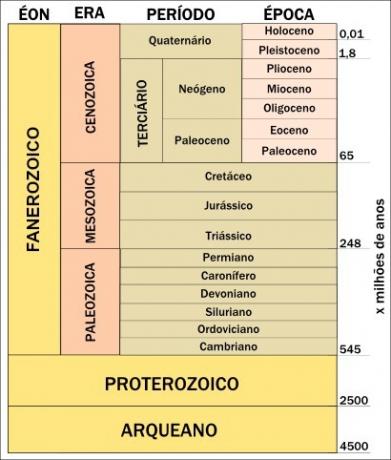Planet Earth, most likely, is about 4.6 billion years old. This means that it is quite old, depending on the frame of reference, because, if we consider the age of the universe (13 billion years), our planet is not that “old”; but if we compare with the time of formation of civilizations, then the Earth's age is very wide.
For this reason, there are two main time scales: the geological time and the historical time. How are scales different, their measurement is also so, so that the proportionality between one and the other is quite different in terms of amplitude.
When we talk about geological time, we refer to a time scale that is usually measured in millions or even billions of years, such as the classification of geological ages and their respective periods. When we talk about historical time (including, there, Pre-History), we refer to the period of emergence of humanity, which corresponds to the use of measurements of tens, hundreds and even thousands of years.
Note the table below, which indicates the succession of the different periods and eras of the geological scale of time:

Geological time scale table
Considering all these transformations the Earth has gone through, we may be perplexed by the we discover that the first humans in their present forms only appeared in the quaternary period, the last of them. This means that while the planet is four and a half billion years old, human beings have inhabited it for just a few sets of millennia.
Therefore, this difference between one time scale and another can be, for us, something difficult to imagine. To make this task easier, we can make some metaphors, for example:
- If the entire geological time was reduced to one day, the first civilizations would have emerged in the last three seconds.
- If we summarized the entire history of the Earth in one year, the first men would have appeared in the last hours of December 31st.
- If every day on Earth were written in a book of 460,000 pages, the human being would have appeared for the first time on page 459,600.
Thus, when we say, for example, that the relief of Brazil is geologically old, it means that it has a formation date that takes longer than that of other places. On the other hand, when we say that modern folds are recent formations, it does not mean that they have emerged a short time ago in historical terms, but a few hundred thousand years ago, which is very little compared to the age of the Earth. For this reason, it is very important that we know the difference between historical time and geological time!
By Me. Rodolfo Alves Pena
Source: Brazil School - https://brasilescola.uol.com.br/geografia/tempo-historico-tempo-geologico.htm
